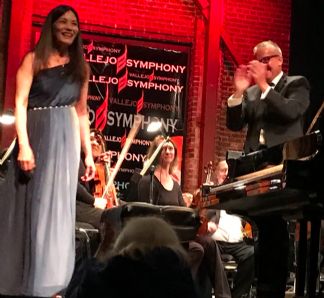|
Symphony
FROM THE NEW WORLD TO THE OLD WORLD
by Peter Lert
Saturday, June 14, 2025
Chamber
MC2 DUO RECITAL CLOSES 222'S SEASON
by Terry McNeill
Saturday, June 14, 2025
Choral and Vocal
CANTIAMO SONOMA'S LUSCIOUS A CAPELLA SINGING IN SEASON ENDING CONCERT
by Pamela Hicks Gailey
Sunday, June 8, 2025
Symphony
SRS SEASON ENDS WITH RESOUNDING TA-TA-TA-BANG
by Terry McNeill
Sunday, June 1, 2025
Symphony
YOUTHFUL VIRTUOSITY ON DISPLAY AT USO'S MAY CONCERTS
by Peter Lert
Saturday, May 17, 2025
Symphony
MYSTICAL PLANETS AND LIVELY GERSHWIN ORTIZ AT FINAL SRS CONCERT
by Peter Lert
Sunday, May 4, 2025
Symphony
VSO'S CONCERT MUSIC OF TIME, MUSIC OF PLACE
by Peter Lert
Sunday, April 27, 2025
VOCAL ELEGANCE AND FIRE AT THE 222'S RECITAL APRIL 26
by Pamela Hicks Gailey
Saturday, April 26, 2025
CANTIAMO SONOMA SINGS AN INSPIRED GOOD FRIDAY MOZART REQUIEM CONCERT
by Pamela Hicks Gailey
Friday, April 18, 2025
DRAMATIC SHOSTAKOVICH SYMPHONY CLOSES PHILHARMONIC'S 25TH SEASON
by Terry McNeill
Sunday, April 13, 2025
|
 |
 Cecile Licad and Marc Taddei April 15 (JCM Photo) |
SPLENDID JUPITER AND ZOOMING CONCERTO AT VALLEJO SYMPHONY SEASON FINALE
by Terry McNeill
Sunday, April 15, 2018
Over the past two years the Vallejo Symphony has made big changes, moving from a stark middle school auditorium to the snazzy remodeled 1911-era downtown Empress Theater, and engaging Marc Taddei as its seventh conductor. April 15 was the season’s final concert of the 86th season.
In a programming novelty the same pianist, Cecile Licad, played in each of the season’s three concerts, and in this afternoon’s concert the St. Saëns G Minor Concerto, Op. 22, was a featured work. The composer’s C Minor Concerto is arguably a more concise and greater piece, and the showy F Major (“Egyptian”) more sonically extravagant, but the G Minor second concerto never fails to charm audiences. And Ms. Licad did so, playing to loud acclaim from the packed 423-seat theater. But it was a performance that nearly went off the rails at many places, and was artistically lacking refinement and nobility.
Ms. Licad’s solo opening was mundane, at least compared with Mikhail Pletnev’s recent imaginative traversal, but the important interpretive misstep throughout were fast tempos and coarse pianism. The soloist was not a colorist, and the concert piano had a powerful bass register and thin treble that at many times covered the full orchestra sound. I thought I would never write that line in a review – piano covers full orchestra. Perhaps Anton Rubinstein in the 1870s, Hofmann in the 1920s or Horowitz in the 1960s. But Ms. Licad managed to hammer so forcefully that the charm and instrumental lines of the popular St. Saëns were submerged. This was especially apparent in the presto finale where the pianist’s manifold scales were continually blurred, wrong notes crept into the mix and the orchestra seemed to be hanging along for the racehorse ride.
The results were clamorous, and conductor Marc Taddei bears some responsibility for the breakneck speed and sonic mess. But it was an exciting mess, and the standing ovation was quick and long. Ms. Licad returned and played an encore of Chopin’s D Flat Waltz, Op. 64, No. 1 (“Minute”), in a dull reading that lacked elegance and omitted the now popular lilting descending thirds in the penultimate measure.
Perhaps the Empress’ direct, non-reverb acoustics contributed to the Concerto’s disorder, but following an extended intermission Mr. Taddei drew from his Orchestra a splendid reading of Mozart’s last Symphony, the “Jupiter” in C Major, K. 551. Conducting without score, as he did in the concert’s opening Tchaikovsky “Hamlet” Overture, Mr. Taddei adopted brisk tempos but phrases never sounded rushed, and instrumental section balances were exemplary. Attacks and releases were crisp and husky violin projection of themes, always a shortcoming for Northern California community orchestras such as the Sonoma County Philharmonic, here were richly played. The VSO is a professional ensemble.
In the andante cantabile second movement the antiphonal string effects were lovely, as the conductor seats the cellos stage left, gaining low string sonority. Fine horn playing (Margarite Waddell, principal) characterized the third movement, though here top register violin sound seemed to be stretched thin. Principal timpani player John Weeks played a major role in all four movements.
Then came inexorably the final movement of Mozart’s final Symphony, called by the conductor in audience remarks the greatest symphony ever written. The polyphony of the repetitive three and four-note phrases built inexorably, firmly in C major and at a clip swifter than all the preceding. Mr. Taddei took 12 minutes to cover a cosmos of emotion and palpable joy, but he was not in a rush to get anywhere, and took the two forte concluding three-note chords with a perfectly gauged fermata. It was consummate and controlled conducting, and clearly Mozart is close to Mr. Taddei’s artistic center.
Tchaikovsky’s Hamlet from 1888 has strains of the contemporary Overture to Romeo and Juliet and his opera “Eugen Onegin,” and showcased the Vallejo Symphony’s first-cabin wind section and solo oboist Curtis Kidwell. Instrumental contrasts and the composer’s masterful orchestration were deftly presented. A perfect concert opening performance.
Prior to both concert halves Mr. Taddei spoke at length, probably too much length, of a performance the next day in the same Theater of the Mozart Symphony for 800 school children, and plans for the 2018-2019 season. For the first time the Vallejo Symphony will play at least one of their concerts twice (Saturday evening and Sunday afternoon, March 30 and 31) in the Empress, and will feature the spiritual Fauré Requiem and Sibelius’ short but profound final Symphony.
|

